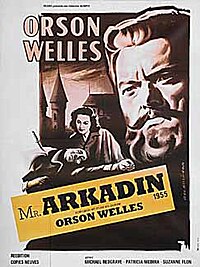
Mr. Arkadin (The Comprehensive Version), 1955 (2000s)
Dir: Orson Welles (Edited by Euro-trash film scholars)
September 11, 2009
This fragmentation of a film might have been a masterpiece had Welles been given complete artistic control over the production, but as it stands, even in a comprehensive version put together with Welles' notes and whatnot, it's just a mishmash of 5 different versions that have come out over the years. What has been put together, however, is interesting in that it shows again the amazing directorial ideas that Orson Welles had, while putting them on a massive scale, just like Citizen Kane (1941).
After losing creative control over the film, Welles called Mr. Arkadin the "greatest disaster of his life." The producers then cut down the length of the film and even over-dubbed some scenes to change the themes to fit the more commercialized idea of a Noir at the time. One of these themes revolved around memories and false impressions, which played into the flashback sequences he had been directing, but was changed to revenge. Two of the versions used to piece this together were Spanish versions, and some scenes were even shot in Spanish, so of course, they are dubbed over and look decidedly sloppy. The story itself, though, when put back in the order most likely to be what intended to be Welles' vision, is a huge Wellesian romp through the power of human deceit and what people will do to cover their tracks.
Small time smuggler Guy Van Stratten (Robert Arden) is at the scene of a murder with his girlfriend Mily (Patricia Medina) where the dying man whispers two names that he claims are very valuable, one of which is Gregory Arkadin (Orson Welles). Right away the film sets up mystery and intrigue, all within the acting of a post-Ambersons Welles production, which almost always borders on camp (particularly Arden as the chuckle-head Van Stratten), but still resonates, particularly in bringing you into Welles' world, who never wants you to forget that you are in fact watching a film. It's just that extra bit a flamboyant acting/cinematic flair that distinguished Welles' work from the rest of the pack. In the Noir world that Welles brings us into, it's almost like he thinks it's funny to have such dopes running around in it. Using this small bit of information and lots of bluffing while sweet-talking Arkadin's daughter Raina (Welles' then girlfriend Paola Mori), Van Stratten manages to meet the apparent multi-millionaire business magnate and socialite Arkadin, who then hires Van Stratten to research his own past, of which he claims to have no memory before 1927.
When we think the film starts to track down one course, Welles flips it. Of course, the real villain of the film isn't so black and white as first made out, and his real motivations to be dastardly aren't as simple as a normal audience might expect (even enough to make him a slightly sympathetic, if unlovable sociopath.) Everything about Arkadin screams fake (uhhh, the beard: low budget for costume design, Orson?), which is a nice parallel to the film, which seems cheap, trashy, and overly-dramatic, but still infinitely watchable.
Of course, the film wouldn't be what it is without its visual aesthetic:




Whether it's deep focus, expressionistic lighting, high/low camera, what you get in front of you is the Welles eye; mise-en-scène at it's greatest heights. There is a technical trick in this film to satisfy all the film geeks. There is one particular scene where Mily, following up a lead by traveling with Arkadin on his yacht, is drunk and her P.O.V shot looking up at Arkadin is accentuated by the deep focus and the rocking ceiling set that gives the appearance of a yacht on the sea, which is perhaps only more appropriate given her drunken state and Arkadin's air of menace. The effect practically made me nauseous watching it. It might be my favorite scene in the film.


In the end, it's hard to say what this film might have been. A masterpiece? Maybe. However, what we're left with is a jumbled mess. Logical, coherent plot? No. Believable acting? No. Deeper Message? Not really. Great Film? I'd have to say, "yes!" There is just something that makes this film work, which, if anything, I would probably have to point to its rhythm. Sure the cinematography is excellent, as exemplified, but here, perhaps more than any of his other films, Welles (or editors) really hypnotizes the viewer through his excellent sense of images and their cohesion. In that way, it sorta feels like The Lady From Shanghai (1947). If the double-crossing producers saw this, they'd shit the bed, but I'm glad we got this fun, if flawed film reconstruction.


2 comments:
Coner, you should see "F is for Fake." It is Welles doing everything he possibly can to fuck with the audience. Classic.
I'll get there, don't worry.
Post a Comment